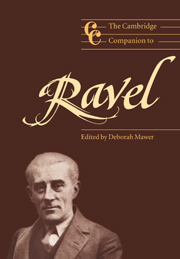Book contents
- Frontmatter
- Introduction
- Part I Culture and aesthetic
- Part II Musical explorations
- 4 Ravel and the piano
- 5 Harmony in the chamber music
- 6 Ravel and the orchestra
- 7 Ballet and the apotheosis of the dance
- 8 Vocal music and the lures of exoticism and irony
- 9 Ravel's operatic spectacles: L'Heure and L'Enfant
- Part III Performance and reception
- Appendix: Early reception of Ravel's music (1899–1939)
- Notes
- Select bibliography
- Index of names and works
9 - Ravel's operatic spectacles: L'Heure and L'Enfant
from Part II - Musical explorations
Published online by Cambridge University Press: 28 September 2011
- Frontmatter
- Introduction
- Part I Culture and aesthetic
- Part II Musical explorations
- 4 Ravel and the piano
- 5 Harmony in the chamber music
- 6 Ravel and the orchestra
- 7 Ballet and the apotheosis of the dance
- 8 Vocal music and the lures of exoticism and irony
- 9 Ravel's operatic spectacles: L'Heure and L'Enfant
- Part III Performance and reception
- Appendix: Early reception of Ravel's music (1899–1939)
- Notes
- Select bibliography
- Index of names and works
Summary
Among strategies for the study of the elusive Ravel is that of the ubiquitous ‘compare and contrast’ approach: Debussy and Ravel give insights by refraction even though their theatrical works could hardly be more different. If Ravel attended all the performances in the first run of Debussy's Pelléas, no wonder his two completed ‘operas’ are nothing like Debussy's: he knew he had to be different.
L'Heure espagnole in context
L'Heure espagnole was written between April and October of 1907, orchestrated in 1910, and described as a ‘comédie musicale’. It was around this time that Ravel's professional relationship with Debussy crossed the thin line from respect to rivalry. In 1906, there was the welldocumented conflict with Pierre Lalo when Debussy was credited with an innovatory style of piano writing which Ravel felt he had initiated in Jeux d'eau. In 1907, a further accusation was the last straw, this time of Debussy's plagiarism, in ‘La Soirée dans Grenade’, of a harmonic ‘trouvaille’ from Ravel's early ‘Habanera’ from Sites auriculaires. All the more reason for Ravel to distance himself from Debussy. This latter furore may have suggested that Ravel was particularly proud of his Spanish innovations. Manuel Rosenthal noted the strength of the composer's relationship with his mother, of ‘basquo-ibérique’ descent: there was a strong sense of his belonging to Spain, and of Spain belonging to him, as it could not have done to Debussy.
- Type
- Chapter
- Information
- The Cambridge Companion to Ravel , pp. 188 - 210Publisher: Cambridge University PressPrint publication year: 2000
- 3
- Cited by

